The task of all conscious and responsible parents is to guarantee the safety of their child when traveling by car. This can only be done by seating the baby in a special device - an infant carrier or car seat. They are made taking into account the physiology of the baby and must pass crash tests to check the reliability and safety.
Many young parents confuse a car seat with a car seat. The bassinet is similar to the carrier baskets often sold with pushchairs, but it's a bit stiffer and has a seat belt for the baby. In it, the child can only be located in the prone position.
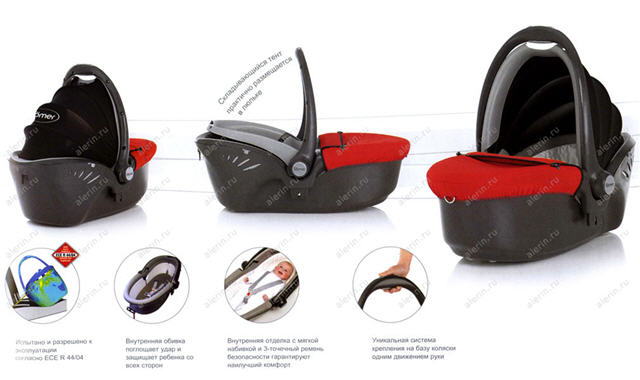
The infant car seat is usually placed in the back seat and fixed with regular belts security. Mounting methods may vary slightly. While driving, the baby is perpendicular to the road in a horizontal position with a flat back. It is comfortable for babies and promotes normal breathing.
In terms of overall safety indicators, car seats are significantly inferior to chairs. Children are more likely to be injured due to the horizontal position of the body. In addition, moving head forward is safer than perpendicular to the road due to the structural features of the baby's body.
Most stroller manufacturers try to equip removable cradles and seats with seat belts, and position them as infant carriers. Often, parents, trying to save money, purchase such strollers 3-in-1 or 4-in-1. It's actually quite dangerous.
Most stroller cradles are not strong enough to protect the baby. In addition, they rarely pass the necessary crash tests. You should not use such infant carriers for transporting children.
At what age can a child be transported in a car seat
The cradle is a device designed for the little ones. In it, unlike car seats, the baby lies, and is not in a semi-sitting position. Many experts believe that it is more comfortable for the child, does not overload the back and neck. Therefore, infant carriers are often recommended to be used from birth until 9 months, when the child is already sitting more or less confidently.
It should be noted that no harm from transportation in car seats, even newborns, has yet been recorded. The half-sitting position is physiological for babies and all statements about its dangers are nothing more than the personal opinion of some experts.
As for the question “at what age can a child be put in a car seat”, the answer here is unequivocal - from no one. The infant carrier is not intended for sitting. In this position, the child cannot be fixed with belts, which means that its transportation will be even more dangerous than in the hands of adults.
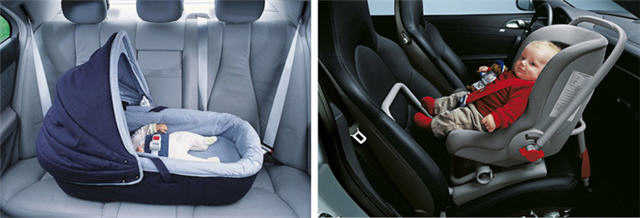
If you can choose, it is better to give preference to a high-quality modern car seat category 0+. Its shape is developed taking into account the anatomical features of the child's body, so you should not worry that a reclining position will negatively affect health. Armchairs are installed with their backs in the direction of travel, and special pads are used for additional fixation of the head. Therefore, even at the moment hard hit the car seat protects the neck and spine of the child, but the infant carrier does not provide such protection. Moreover, the lying position of the child during an accident is considered the most dangerous.
One of the minuses of the cradle is its massiveness. When installed, it occupies most of the rear seat.
The best choice for the safety of your baby from birth is a quality 0+ car seat with five-point seat belts and special fasteners for attaching to the car. The infant carrier is also not prohibited from being used to transport children from birth, but its safety is much lower. Therefore, today cradles are recommended to be used only when there are medical contraindications for transportation in a chair.
How younger child, the more fragile it is, and newborns are the most vulnerable age category. Their bones are soft and flexible, and there is a lot of cartilage in the skeleton. The mass of the head, relative to the body, is 25% (in adults - 6%). At the same time, the neck of the infants is thin and the muscles are poorly developed. It is dangerous to shake the baby even intensively on the hands, and with a strong push, the “heavy” head is sharply thrown away, and the main load falls on the neck area. The respiratory organs in infants also have their own characteristics, which create the prerequisites for a milder respiratory disorder than in adults.
Today, car cradles (car beds, car seats) and chairs are used to transport newborns in a car.
Car cradles
From what age can a baby be transported in a car seat?
From birth to 6 months.
In the cradle, the child is transported lying down. It is installed on the rear sofa of the car perpendicular to the movement and is fixed with the help of car belts. In the car seat itself, the child is fastened with built-in belts.
3
In the cradle, the child lies horizontally. The car bed is installed perpendicular to the movement, on the back sofa of the car.
4
The car seats are fixed with the car's standard belts. Strapping methods may vary.
The main advantage of infant carriers is that the child lies horizontally and this contributes to the normal breathing of the baby as much as possible. The overall safety performance of cradles, as a rule, is inferior to car seats.
Very often, stroller manufacturers simply complete removable cradles with additional mounts, which allows them to be used in a car. But “pushchair” infant carriers are usually not strong enough to keep a child safe in a car, and therefore not suitable for carrying babies.
The disadvantages of cradles include the fact that they take up a lot of space in the car.
Therefore, infant carriers should only be used for special medical reasons.
car seats
At what age can a baby be transported in a car seat?
Just like in a car seat - from the first days of life
In car seats, a newborn is transported reclining, at an inclination of 30-45 degrees, with his back in the direction of travel. The seat itself is fastened either with regular car belts or with special ISOFix brackets. The child in the car seat is held in place by internal straps.
5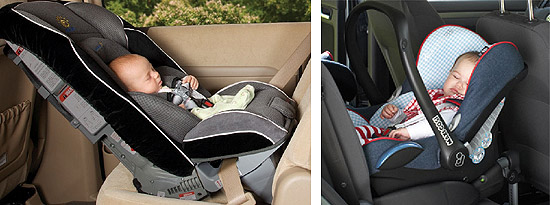
The first picture shows a universal chair that can be used for both babies and older children.
In the second picture is a car seat carrying, which is used for children up to a year and a half. In these chairs, the child can be carried outside the car, thanks to a special handle.
The main advantage of car seats is that they provide better child safety than carrycots. Armchairs hold the baby's head well in case of a frontal impact, excluding traumatic loads on the neck. And this, according to statistics, is about 70% of accidents.
It is very important that the inclination of the seat back is correct, and is within 30-45 degrees. A shallower angle (more than 45 degrees) greatly reduces the safety of the car seat in frontal impacts. If the position is too high (angle less than 30 degrees), the child's head will fall forward, which can lead to difficulty in breathing, and, as a result, to insufficient oxygenation of the blood, and in very rare cases, to respiratory arrest.
6
The angle of inclination of the seat back should be within 30-35 degrees.
The optimal angle is 45°.
7
a) Seat angle too low (
b) Backrest tilt from 30° to 45°. The newborn is in maximum safety with sufficient comfort.
c) Photo taken during crash tests during a collision. The backrest angle is too gentle (>45°), which does not provide adequate safety for the child in an accident.
The optimal back angle is 45°. This inclination provides an optimal ratio of safety and comfort during road trips.
As a rule, the angle of inclination of modern chairs ensures the safe transportation of the child, but its value may be different depending on the shape of the seats of a particular car. It is allowed to use rollers to correct the inclination of the car seat, for example, from tightly rolled towels, which are placed under the front of the child seat.
8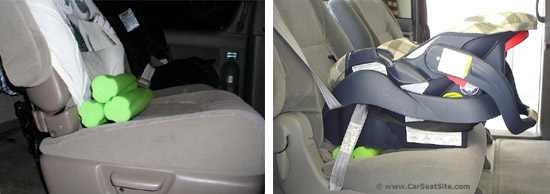
Rollers can be used to correct the angle of the car seat.
For additional fixation of the child's head, it is allowed to use fabric rollers that are placed on both sides of the newborn. Various pillows, liners for the head, which are not included with the chair, are prohibited, as this may contribute to the child's head falling forward.
9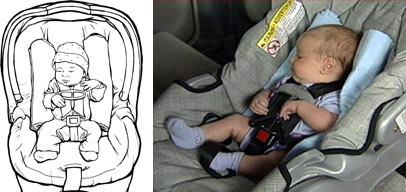
For additional fixation of the child's head, it is allowed to use rollers, for example, from folded towels
There is a widespread opinion among parents that it is harmful for a newborn to sit in a car seat, as this can damage his spine. In fact, these fears are groundless because the child does not sit upright in the car seat, but reclining. I do not put dangerous loads on the spine. The weight is evenly distributed across the back.
10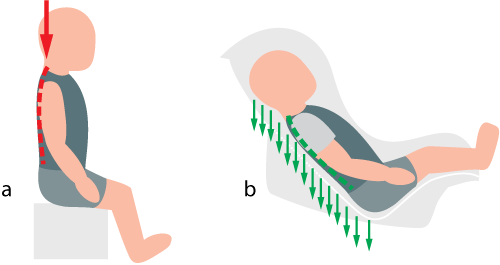
a) Dangerous vertical loads on the spine of the newborn under the influence of his weight.
b) In the semi-sitting position, there are no vertical loads on the spine. The weight is distributed evenly over the entire area of the back.
If the chair is correctly installed, the time spent by the baby in it does not exceed one and a half hours, then there is no risk to the child's health.
Summary: car seat - safe way transportation of babies in a car from the first days of life. In it, the child is transported half-sitting with his back in the direction of travel. It is important that the slope, the back of the chair is within 30-45 degrees. Infant carriers in which the child is transported lying down should only be used in case of special medical indications.
Backward forward - as long as possible!
In the event of an accident, the risk of death or serious injury in a child under two years of age is reduced by 5 times if he sits backwards!
This was confirmed by the results of a large study conducted in the United States in 2007. Data collected over 15 years on car accidents involving children under 2 years of age who were transported in car seats were analyzed. Statistical analysis showed that forward-facing children were 75% more likely to be injured.
11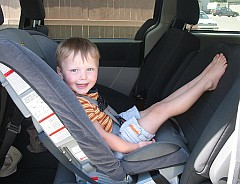
Why does the back-to-back arrangement guarantee a higher safety for the child?
To understand this, we need to remember two very important moments. Firstly, according to statistics, in car accidents, frontal (frontal) collisions most often occur, which are the most dangerous for passengers, since the resulting speeds, and with them the overloads in this case, are maximum. Secondly, a child (especially younger than 3 years old) is a much more fragile and delicate creature than an adult. At the same time, the head of the child, relative to the body, is heavier than that of an adult.
So, imagine that there was a collision - the most frequent and dangerous, frontal. Figure 2 shows two options: A - a child in a car seat facing in the direction of travel, B - with his back in the direction of travel.
12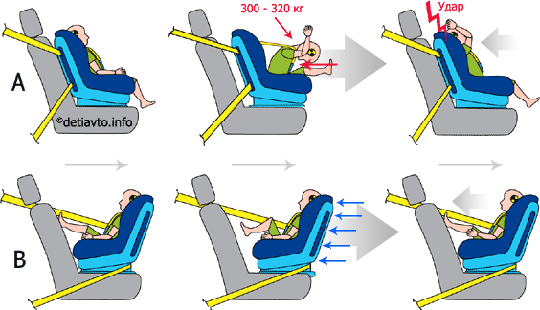
Figure 2. A - facing in the direction of travel, B - child in a car seat with his back in the direction of travel.
If a child, during a frontal collision, sits facing in the direction of travel (A), then his head is not fixed by anything. By inertia, it is sharply thrown forward, hits the sternum and is thrown back with force. The main loads, in this case, fall on the neck, spine and chest of the child. With a resulting speed of 80 km / h, a force equivalent to 300-320 kg acts on the child's cervical region! Due to the fact that the vertebrae, ligaments and muscles of the child are not sufficiently developed and cannot serve as sufficient protection, a destructive load is placed on the spinal cord. Appropriate crash tests have shown that the neck of the child anatomy dummies is extended by more than 5 cm, while the spinal cord can withstand a stretch of no more than 5 mm. In fact, there is a hidden decapitation.
It is appropriate to quote from a medical source: “At autopsy, samples of the vertebrae and ligaments of infants can withstand a stretch of up to 5 cm, but the brain tissue itself is torn if it is stretched a little more than 0.5 cm” *.
In addition, a force equivalent to 900-960 kg acts on the child's chest, locally, under the car seat belts. The soft sternum and ribs cannot protect vital organs such as the heart and spleen from damage.
If a child, during a frontal collision, sits with his back in the direction of travel (B), then by inertia he continues to move forward and is pressed into the back of the car seat. In this case, the load is distributed proportionally across the back of the head, neck and back. Of course, it all depends on the strength of the impact, and no chair gives a 100% guarantee, but in this case the risk of serious injury is minimized.
Until what age should a child ride backwards?
As long as possible! Consider the eloquent example of Sweden, where children drive "back to front" until the age of 3. The minimum age, according to the recommendations of pediatricians, is 1 year. More accurately, you need to navigate by the weight of the child, so that it does not exceed the maximum allowed for the previous chair, and height - so that the top of the head is not higher than the back of the previous chair.
At least up to a year, the child must be carried with his back in the direction of travel.
Often on forums for parents-motorists there is such a question: “How can I carry him backwards up to 3 years, where will he put his legs?” Parents forget that such a position - with bent legs apart ("toad") - is natural for the baby, and does not cause discomfort.
Many parents are in a hurry to transplant the child in the direction of travel, saying that he does not like to sit back forward, that he is interested in watching the road, that it is more convenient for them to follow the child. Perhaps these reasons seem important to them. But they are incomparable with the most important reason in favor of the position of the seat back forward - it saves the life and health of the baby much more efficiently!
Summary: The position of the back forward in the direction of travel is the safest for a child under 3 years old. Research evidence confirms that a child in a rearward facing car seat is at much lower risk.
Frequently asked Questions
Can newborns sit in a car seat? After all, you can’t load the spine so small!
The newborn does not sit in the car seat, but reclining at an angle of 30-45 degrees. In this position, the load is distributed throughout the body and does not exert vertical pressure on the spine. There is some squeezing effect in the car seat abdominal cavity a child, which, due to the specifics of the respiratory organs of a newborn, can lead to insufficient blood oxygen saturation. But studies have shown that if a child is in a chair for less than an hour and a half, then this is not harmful to his health. It is very important that the inclination of the seat back is correct, and is within 30-45 degrees. A shallower angle (more than 45 degrees) greatly reduces the safety of the car seat in frontal impacts. If the position is too high (angle less than 30 degrees), the child's head will fall forward, which can lead to difficulty in breathing, and, as a result, to insufficient oxygenation of the blood, and in very rare cases, to respiratory arrest.
What is the safest child car seat?
Why do we need child car seats at all?
Road traffic accidents top the list of causes of death of children aged 1 to 14 years in an accident. According to statistics, the correct use of child safety equipment reduces the risk of serious injury or death of a child by 34 times! Those. about 97 children out of 100 would not be injured or killed if their parents bought a car seat and installed it correctly!
The child sits in the adult's arms and is held tightly. Isn't that enough?
This is not only not enough, but also represents an additional danger to the child. During a collision, there are colossal overloads. The weight of all objects under their influence increases tenfold! For example, in a collision at a speed of 50 km / h, the weight of a five-kilogram baby would be 300 kg. And at a speed of 70 km / h more than 400 cells! What can we say about older children. No hands can hold them. So besides, the weight of the adult who held him can still fall on them - and this is already tons (about 4 tons, if the weight of an adult is 70 kg). Therefore, in no case should you carry a child in your arms. And one more fact - at a speed of 50 km / h, the probability of death of a child sitting in his arms is about 70%
What are car seats for newborns? About what to look for when buying, how to properly put the baby in the car seat, and what ensures the safety of the crumbs in the car - read the article.
Carrying a newborn in your arms means putting him at risk even at low speed! A car seat (car seat) for a newborn is mandatory. Parents should remember not to use the same car seat for a child of all ages.
Safety car seat: where is the warranty?
The safety of the baby in the car is ensured by such parameters of the child car seat as:
- protects against side impact. According to numerous studies, it is a side impact that is most dangerous for a small passenger.
- securely fastened to the vehicle. The child must remain fixed, including during sudden braking.
- simple operation. According to sad statistics, a significant part of the injuries occur due to improper installation of a child car seat in the car.
Manufacturers of child car seats came to these obvious things now about 30 years ago. Prior to this, the function of car seats for newborns and older children was to keep the child in one place while the car is in motion.
But the development of the global automotive industry as a whole, the increase in speeds, the number of cars and the increased attention to the safety of passengers led to the adoption of uniform European standards for the safety of child car seats. Since 2009, this has been the ECE R44/04 standard, which complies with Russian GOST. Please note that the previous version of ECE R44/03 is less rigid than the current one.
The first child car seat appeared in 1935 in America. But then the device did not serve to ensure the safety of the baby in the car, but to ensure that the child did not crawl around the cabin and did not interfere with driving.
Innovations for child car seats: ECE and i-size
In the summer of 2013, a new system of standards for child car seats appeared - i-size. The introduction of a new label does not mean that chairs made earlier are unsafe. It's all about the development of road safety techniques.
i-Size takes into account the latest research, the gradation of car seats has changed regarding the weight and height of the child, and side protection has been strengthened. But, at least until 2018, the ECE 44/04 and i-Size standards operate in parallel, which means that car seats with the ECE 44/04 marking that have already become familiar will not disappear from Russian stores.
The I-size standard obliges that the child car seat in the car will be attached exclusively using the isofix system. If your car does not provide such special fasteners (this can be clarified in the car modification), then the i-size marked seat will not suit you, only ECE.

Do not confuse ECE R44/04 and Isofix
ECE R44/04 is a child car seat safety standard that includes several parameters regarding side protection, fastening systems, seat model depending on height and weight. This marking must be on the car seat.
Isofix is just a mounting system, nothing more. There are two ways to attach a child car seat: using a standard car seat belt and using Isofix anchorages.
Please make sure that the car seat you are purchasing has the European marking ECE R44/04. This marking is fully consistent with Russian GOSTs.
In some countries, for example, in the UK, Israel, Canada, the mother simply will not be allowed out of the hospital until she guarantees that the newborn will go home in a car seat.
Myths about transporting newborns in a car
The most common judgment is that it is supposedly possible to transport a newborn in the arms of an adult or in, especially if the road is short. Those who claim this refer to the fact that they have never heard of car seats for children before, and the driver will be extremely careful.
But you absolutely cannot do this! Yes, before there were no car seats for newborns with such a strong and complex system protection as now, but think about how the traffic situation has become more complicated, how much the speed of movement has increased over last years, and then it will become clear why a child car seat is now vital. In addition, a catastrophe can happen at a relatively low speed of 30-40-50 km / h. Therefore, remember: a newborn can only be transported in a special car seat, regardless of the distance, speed and duration of the trip!
Another myth associated with transporting children in a car says that a car seat for newborns harms the fragile spine of the crumbs. If you use an older child car seat to transport an infant, then yes, it is harmful. But for newborns they produce special car seats! They differ from others in that the child is not in a sitting position, but lying down, that is, without any harm to the newborn.
If you do not plan to regularly travel with a newborn in a car, then to move home from the hospital, order a taxi, in the fleet of which there is not just a car seat for children, but specifically for babies.
Choosing a car seat for a newborn
As mentioned above, a car seat for a newborn differs from others at least in its design, which assumes a reclining position of the baby in it. Currently, manufacturers of child car seats use five age categories:
What you need to know when choosing and using an infant carrier
The infant carrier is category 0. Outwardly, the infant carrier resembles an ordinary cradle. The child is located in it strictly horizontally, which corresponds to its physiological characteristics. There is no danger to the spine and other parts of the body. This position is familiar to the baby, he also sleeps in the crib.
The car seat is installed only in the rear seat, perpendicular to the movement. The headboard should be turned away from the car door: it is safer in case of a side impact. The car seat is fastened with a standard seat belt. The baby in the car seat is also necessarily fixed with internal wide straps.
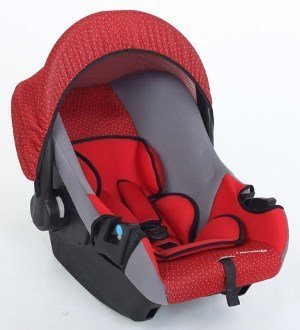

What to look for when choosing a car seat for a newborn:
- Depth. When evaluating this parameter, remember that the child will be in the infant carrier in clothes, including winter voluminous overalls.
- The car seat should fit snugly against the car seat, practically not moving on it.
- Before buying, check if there are enough regular seat belts in your car to attach the infant carrier.
- Check the car seat body for "fragility". It is the body that mainly ensures the safety of the baby.
The disadvantages of the car seat is that usually by 6-9 months the child "outgrows" it. Therefore, it is better to consider the option of auto-carrying.
Car seat price: from 5,000 rubles.
Do not confuse a car seat with a rear-facing car carrier.
What you need to know when choosing and using auto-carry
An auto carrier (marked as 0+) is also intended for children from birth, but has a number of significant differences from an infant carrier. Outwardly, the car carrier looks more like a car seat for older children than a cradle. It is also convenient because it has a handle for transporting the car carrier along with the baby outside the car. It is used for children up to one and a half years or until the weight has reached 13 kg.
In the car carrier, the child is in a reclining position, because the back of the carrier is set at an angle of 30-45 degrees.
For those who have not yet encountered an auto-carrier, it seems that the child is sitting in it. But in fact, the position of the baby with the back of the car carrier correctly adjusted is the same as if he is lying in your arms.
The car carrier is installed in the back seat, preferably behind the driver. Do not keep foreign objects in the rear seat when the infant carrier is there. You can also place the infant carrier on the front passenger seat, but then the airbag must be turned off! Unlike the car seat, the car carrier is placed, like the car seat for older children, that is, not perpendicular to the movement. Please note that it is better to install an autocarrier (or a car seat for newborns) against the direction of the car.
There are two options for mounting the car carrier in the car. The first is with the help of regular seat belts. The second is through special isofix mounts. In the second case, such a system should be in your car. But basically all cars manufactured after 2003 have isofix mounts.
If you buy a car seat, it does not matter if your car is equipped with an isofix attachment system. If auto-carrying, check the compatibility of the machine and auto-carrying in terms of attachments.
What to look for when buying a car carrier:
- Possibility to adjust the inclination of the back.
- Fastening reliability.
- Compatibility of car carrier mounts and your car.
If you have bought a car carrier, it is better to supplement it with a special insert for a newborn, which will provide a better position for the baby in the car carrier.
Car carrier price: from 5,000 rubles, an insert in a car carrier for newborns - from 1,000 rubles.
There are strollers that, judging by the manufacturer's description, have a removable car seat. Outwardly, it may look quite suitable for transporting a baby. But, unfortunately, crash tests show that the infant carrier from the stroller is unsafe.
Car seat: from birth to 3-4 years
This is an intermediate category designed to save the family budget. Such car seats are marked as 0-1 and are suitable for children weighing no more than 18 kg. The requirements for a car seat are the same as for a car carrier. However, it is highly recommended to use a newborn insert.
Price: from 8,000 rubles.
Even a small accident can lead to deformation of the car seat, invisible to the eye, which can subsequently affect the safety of the baby. Therefore, if you decide to buy a used child car seat, it is better to purchase it from friends.
From the first days of a baby's life, it is necessary to take care of his safety when transported in a car. Standard child seats are not suitable for a child under one year old; a car seat for newborns was specially developed for this case. A convenient and easy-to-use device provides children with a secure fit, a comfortable position and can be used not only for its intended purpose: it can replace a special deck chair for parents for the first time. To date, there are several dozen different models that differ not only in external data, but also in functionality. To choose the right option, you will have to familiarize yourself with their comparative characteristics.
Car seat: definition, purpose, features
A modern car seat is more like a specific orthopedic car seat, equipped with seat belts to fix a child under the age of 1.5 years. The baby lies or reclines in the device, the features of the device are designed to protect him from damage and a sharp transfer of weight during an accident.
The weight of the structure is about 4-5 kg, there is a special handle for carrying the child. Often, such structures can be installed on the frame of the stroller, which refers to a number of very convenient features. Practically all children's infant carriers are multifunctional; at home they can be used as a chair, crib or rocking chair.
There are models with awnings that protect the baby from the sun and the eyes of strangers. Fixtures finished soft material with seals in the right places, which ensures a comfortable position for the newborn.
According to the type of fixation, three-point and five-point seat belts are distinguished. The second option guarantees a tighter and better hold of the child in place, but requires a careful approach to choosing a model and fitting belts, otherwise the baby will be too tight and uncomfortable.

Types, their characteristics and advantages
Initially, all car seats are divided into two categories:
- 0 - suitable for newborns weighing up to 13 kg, most often used up to 6 months. The design is characterized by a horizontal position of the back. Suitable for premature babies who, due to their physical characteristics, need to stay in a supine position for some time.
- 0+ - used from birth to 1.5 years old with an infant weighing up to 13 kg or more.
In addition, you need to choose the appropriate option for the type of attachment.
- Fixation in the direction of movement of the vehicle.
- Fixation against the movement of the vehicle. It is considered the best and safest option for transporting a child.
- The combined version, which is attached against the course of the vehicle, until the baby has reached a weight of 13 kg. After that, the type of fastening changes, and the cradle is installed in the direction of the car (weight up to 18 kg). Such solutions are very convenient, but, as statistics show, parents prefer to purchase two specialized chairs instead of one combined one.
- Fixation along the rear seat with seat belts. At the same time, the child rides sideways, his body is fixed in the cradle with a wide belt across the chest. This option is typical for the use of a category 0 cradle.
An important role is played by the place of fixation of the cradle. Based on the results of crash tests and numerous tests, optimal options for the location of devices have been established that take into account all children's anatomical features and reduce the risk of injury as a result of an accident or careless driving.
- Behind the driver's seat. Statistics point to this option. This place is the least likely to be damaged, especially if we talk about a direct head-on collision.
- On the center of the rear seat. This place was chosen as a result of psychological research and assessment of the behavior of parents. No matter how strong the love for your child, a person going into a direct collision begins to instinctively twist the steering wheel in an attempt to protect himself. Then the main blow falls on the rear of the car (most often on the passenger side).
- In the front passenger seat. The carrier can also be secured in this position, but only if the child's mother is driving. This approach calms women and allows them to focus on the road. It is important to remember that if you choose this type of installation, you must definitely disable the front airbag. Otherwise, as a result of sudden braking, the system will be triggered, which is fraught with serious injury to the child.
It is forbidden to use cradles from strollers for! Any budget baby carriers will provide a higher degree of safety.
If a device with a backrest is used, then you need to give the child a position at an angle of 30-45 °. If you do more, safety is reduced in a frontal impact, if less, a load is created on all parts of the spine and the breathing process is complicated.
In the first three months of life, special dense rollers can be used to fix the baby's head, this will reduce the risk of injury to the cervical region.
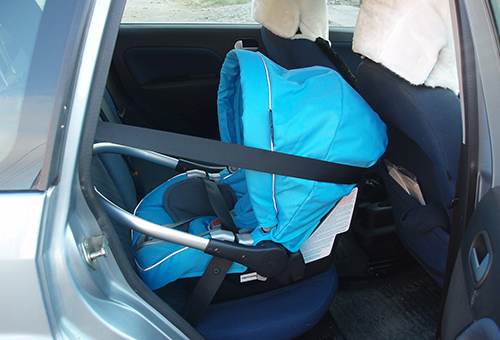
How to choose the right infant car seat?
Choosing the right car seat is not so difficult, you just need to follow certain recommendations.
- You need to proceed from the individual indicators of the baby. His height, weight and age should be taken into account. If there is an opportunity to take it for a “fitting”, it is worth doing it.
- An important role is played by the materials from which the cradle frame and its external decoration are made. In the first case, strength is checked, in the second - hypoallergenicity, environmental friendliness. Fabrics should be breathable and well ventilated. It is better to opt for models with removable covers. Do not get hung up on the fact that the product should have cheerful children's colors. For a baby, this is not yet important, and practical colors do not require troublesome care.
- You cannot purchase used products. If the product has been in an accident, the seller will not admit it, and the safety of such a chair will approach zero.
- The marking of the product located on its body will tell a lot. For example, the ECE R44/03 badge (numbers may be different) indicates European quality, and the number in a circle indicates the country of origin. Any good salon should provide an official transcript of the marking.
- It is worth paying attention to the number of backrest positions and additional options.
- It is best to try to install the cradle in the car before buying and check the length of the belts (sometimes it is not enough). If necessary, you can purchase a new set.
- You should not rely on the stories of sellers, it is better to find crash tests for the model you are interested in and read the reviews of parents about it.
- Models with low weight are considered preferable, but they are somewhat more expensive than heavier counterparts.
It is best to purchase cradles in specialized stores or salons. This will allow you to replace the device in case of non-compliance or a quick breakdown.
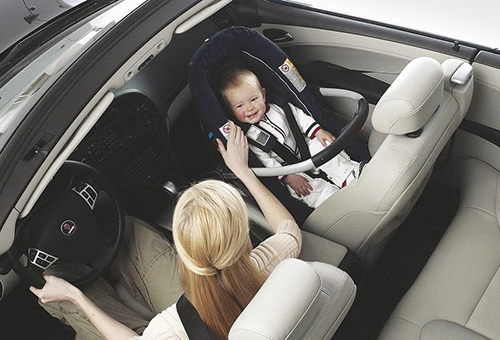
What should I pay attention to when installing the car seat?
There are several options for installing an infant car seat, from the simplest, budgetary to ultra-reliable and innovative.
- With seat belts. A very simple but reliable method. The places for threading the belts must be indicated on the model. Plus, you need to make sure you have detailed instructions on the operation of the device: some models have their own nuances. In this embodiment, the length of the belt is very important; it is often not enough for large models. In this case, you can not deviate from the instructions and try to come up with your own methods of fastening! You need to either replace the model, or pick up other belts.
- The special base-stand will significantly facilitate the process of using the cradle. It is securely fixed on the back seat using belts or a special system, remaining there for the entire period of use of the cradle. The carrier is quickly and easily fastened to the base and does not even require the use of straps. You can initially purchase a ready-made kit or assemble it in parts. In the second case, you need to make sure that the components fit together.
- If funds allow, it is best to choose the option with an additional leg. This device rests on the floor and on the chair, can be adjusted in height and thus creates an additional point of support for the cradle. The design has earned the highest marks on the results of all kinds of tests. True, it is worth considering that there are chairs and cars that are not designed for such a system, this point should be checked immediately.
The infant car seat will ensure the safety of the child only if the operating conditions are observed. It is necessary to regularly check the body of the product for cracks or splits. This may be a sign of internal damage to the system, which reduces its protective properties.
Today on the market there are very wide selection high-quality and affordable models, you should not rely on chance and use items that are not adapted to protect the child.
IS IT HARMFUL FOR THE BABY A SEMI-SITTED POSITION,
because the spine is still very soft?
Can you take the carrycot off the stroller?
here is what I read:
BABIES IN THE CAR.
What should I look for when choosing a car seat for my baby?
For infants, car seats of groups "0" and "0+" are used. Group 0 car seats are infant carriers with internal straps that secure the child. They must comply with ECE R44/03 (or 44/04). For children from birth, it is better to use group 0+ car seats (for children weighing up to 13 kg). They provide a higher level of child safety and are installed facing backwards. Note: It is not recommended to carry newborn children for long periods of time, because in a carThis group (0+) does not have a fully horizontal resting position for safety reasons. In order not to load the fragile spine of the baby, it is necessary to make stops, giving the child a break from the car seat.
Is it safe to use as an alternative to a carrycot from a pushchair with straps?
No. The bassinet will be secured, but the baby in it will not.
How long should the infant seat be used?
As long as possible - until the baby learns to sit correctly, up to about nine months. When his head reaches the top of the seat, it's time to move him to a larger seat (groups "0+/1" or "1"), but still against the direction of the car.

